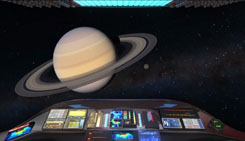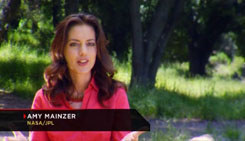Has this episode become THE most famous of the series, now that it has
been re-released on its own in an upgraded 3D blu-ray version?
Though the CGI graphics are spectacular, content counts for more with me.
It's a good episode, but far from my favourite of the series.
All five scientists interviewed appear regularly on this series,
and often repeat things they've either said before or will say again
on other episodes. As a lot of the CGI shots we get are new for this season,
the editor is content to let them play out at full length most of the time,
and we get a nice smooth flow in the visuals.
The 7 Wonders themselves are presented in reverse order:
- 7. Geysers of Enceladus
- 6. Rings of Saturn
- 5. Jupiter's Great Red Spot
- 4. Asteroid Belt
- 3. Olympus Mons
- 2. Surface of the Sun
- 1. Earth
Some of the most interesting discussion points
include the fact that the largest
asteroid in the belt - Ceres - is now
considered a dwarf planet like Pluto.
This episode also introduces one of season five's favourite topics -
coronal mass ejections from the sun.
However, it is the discovery and subsequent 2009 mapping
by the Cassini spacecraft of
ice volcano geysers emanating from "tiger-stripe" cracks
on one side of Saturn's moon Enceladus that remain
the most memorable portions of the episode. Very cool.
Of course, the way the narration is written, you could
easily get the mistaken idea that the Enceladus geysers were
first discovered in November 2009. Sorry,
the geysers were already known in the 2007 episode
Alien Moons [season 2]
as Cassini provided actual data on Saturn's ionosphere.
When it turned out to be only 10% of what was predicted,
the cause was thought to be Enceladus' water geysers.
The final first season episode of "How the Universe Works",
also titled
"[Alien] Moons",
states that the Cassini probe spotted the ice geysers of
Enceladus in 2005.
It's the 2009 close-up maps and additional detail that are new here,
making this one of the most compelling presentations of
the Enceladus phenomenon.
Chapter List (altered for what each chapter REALLY contains):
- Enceladus / Rings of Saturn
- Great Red Spot / Asteroid Belt & Ceres
- Asteroid Impacts / Olympus Mons
- Surface of the Sun
- Earth
Chapter List (as presented on the disc menus):
- Enceladus
- Great Red Spot
- Asteroid Belt
- Surface of the Sun
- Earth
from the disc sleeve:
7 Wonders of the Solar System:
Take an exhilarating, unprecedented tour of
the seven most amazing wonders of our solar system,
including Saturn's famous rings, which contain mountain ranges
that rival the Alps, and Jupiter's Great Red Spot, the eye of
the biggest storm in the solar system.
And the "Ask the Universe" question for this episode is...
"Have movies accurately represented what
the Asteroid Belt actually looks like?"
- Joel T., Kansas City, Missouri.
|
Participants include:
|















